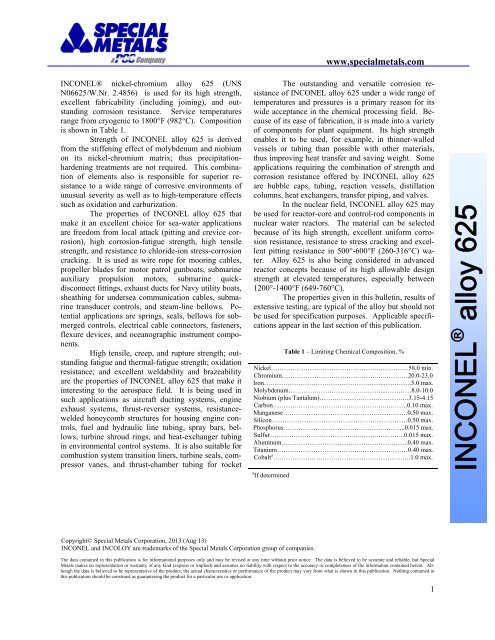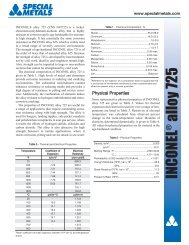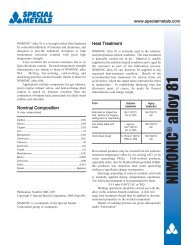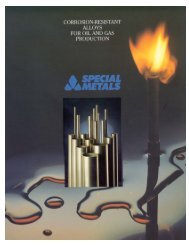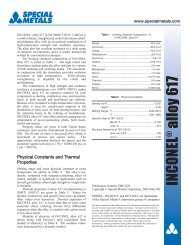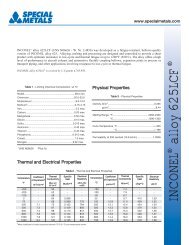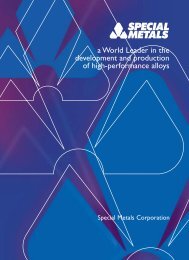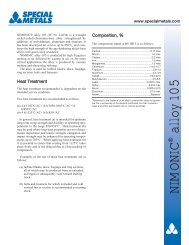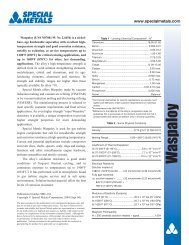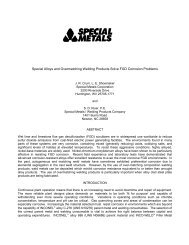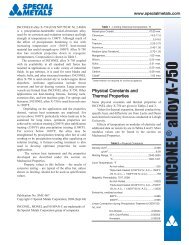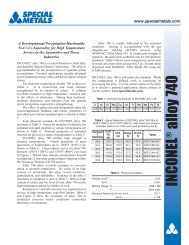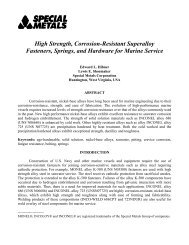Inconel alloy 625.pdf - Special Metals Corporation
Inconel alloy 625.pdf - Special Metals Corporation
Inconel alloy 625.pdf - Special Metals Corporation
You also want an ePaper? Increase the reach of your titles
YUMPU automatically turns print PDFs into web optimized ePapers that Google loves.
www.specialmetals.comINCONEL® nickel-chromium <strong>alloy</strong> 625 (UNSN06625/W.Nr. 2.4856) is used for its high strength,excellent fabricability (including joining), and outstandingcorrosion resistance. Service temperaturesrange from cryogenic to 1800°F (982°C). Compositionis shown in Table 1.Strength of INCONEL <strong>alloy</strong> 625 is derivedfrom the stiffening effect of molybdenum and niobiumon its nickel-chromium matrix; thus precipitationhardeningtreatments are not required. This combinationof elements also is responsible for superior resistanceto a wide range of corrosive environments ofunusual severity as well as to high-temperature effectssuch as oxidation and carburization.The properties of INCONEL <strong>alloy</strong> 625 thatmake it an excellent choice for sea-water applicationsare freedom from local attack (pitting and crevice corrosion),high corrosion-fatigue strength, high tensilestrength, and resistance to chloride-ion stress-corrosioncracking. It is used as wire rope for mooring cables,propeller blades for motor patrol gunboats, submarineauxiliary propulsion motors, submarine quickdisconnectfittings, exhaust ducts for Navy utility boats,sheathing for undersea communication cables, submarinetransducer controls, and steam-line bellows. Potentialapplications are springs, seals, bellows for submergedcontrols, electrical cable connectors, fasteners,flexure devices, and oceanographic instrument components.High tensile, creep, and rupture strength; outstandingfatigue and thermal-fatigue strength; oxidationresistance; and excellent weldability and brazeabilityare the properties of INCONEL <strong>alloy</strong> 625 that make itinteresting to the aerospace field. It is being used insuch applications as aircraft ducting systems, engineexhaust systems, thrust-reverser systems, resistanceweldedhoneycomb structures for housing engine controls,fuel and hydraulic line tubing, spray bars, bellows,turbine shroud rings, and heat-exchanger tubingin environmental control systems. It is also suitable forcombustion system transition liners, turbine seals, compressorvanes, and thrust-chamber tubing for rocketThe outstanding and versatile corrosion resistanceof INCONEL <strong>alloy</strong> 625 under a wide range oftemperatures and pressures is a primary reason for itswide acceptance in the chemical processing field. Becauseof its ease of fabrication, it is made into a varietyof components for plant equipment. Its high strengthenables it to be used, for example, in thinner-walledvessels or tubing than possible with other materials,thus improving heat transfer and saving weight. Someapplications requiring the combination of strength andcorrosion resistance offered by INCONEL <strong>alloy</strong> 625are bubble caps, tubing, reaction vessels, distillationcolumns, heat exchangers, transfer piping, and valves.In the nuclear field, INCONEL <strong>alloy</strong> 625 maybe used for reactor-core and control-rod components innuclear water reactors. The material can be selectedbecause of its high strength, excellent uniform corrosionresistance, resistance to stress cracking and excellentpitting resistance in 500°-600°F (260-316°C) water.Alloy 625 is also being considered in advancedreactor concepts because of its high allowable designstrength at elevated temperatures, especially between1200°-1400°F (649-760°C).The properties given in this bulletin, results ofextensive testing, are typical of the <strong>alloy</strong> but should notbe used for specification purposes. Applicable specificationsappear in the last section of this publication.Table 1 – Limiting Chemical Composition, %Nickel…………………………………………….…………58.0 min.Chromium………………………………………..…………20.0-23.0Iron………………………………………………..………….5.0 max.Molybdenum……………………………….……...…………8.0-10.0Niobium (plus Tantalum)………………………..………….3.15-4.15Carbon……………………………………………..……….0.10 max.Manganese………………………………………....……….0.50 max.Silicon……………………………….…………...…………0.50 max.Phosphorus……………………………………….………..0.015 max.Sulfur…………………………………..……….…..……..0.015 max.Aluminum…………………………………………………..0.40 max.Titanium……………………………….……………………0.40 max.Cobalt a ……………………………………………………….1.0 max.a If determinedINCONEL ® <strong>alloy</strong> 625Copyright© <strong>Special</strong> <strong>Metals</strong> <strong>Corporation</strong>, 2013 (Aug 13)INCONEL and INCOLOY are trademarks of the <strong>Special</strong> <strong>Metals</strong> <strong>Corporation</strong> group of companies.The data contained in this publication is for informational purposes only and may be revised at any time without prior notice. The data is believed to be accurate and reliable, but <strong>Special</strong><strong>Metals</strong> makes no representation or warranty of any kind (express or implied) and assumes no liability with respect to the accuracy or completeness of the information contained herein. Althoughthe data is believed to be representative of the product, the actual characteristics or performance of the product may vary from what is shown in this publication. Nothing contained inthis publication should be construed as guaranteeing the product for a particular use or application.1
Physical Constants and Thermal PropertiesSome physical constants and thermal properties of IN-CONEL <strong>alloy</strong> 625 are shown in Tables 2 and 3. Lowtemperaturethermal expansion, based on measurementsmade by the National Bureau of Standards, isshown in Figure 1. Elevated-temperature modulus ofelasticity data are given in Table 4.Figure 1 – Thermal Expansion at Low TemperaturesTable 2 – Physical ConstantsDensity, lb/cu in………………………………………..………..0.305gram/cc………………………..………………………….8.44Melting Range, °F…………………………….......……….2350-2460°C…………………………………………1290-1350Specific Heat a , Btu/lb°F (J/kg°C)0°F (-18°C)………………………………0.096 (402)70°F (21°)………………………………..0.098 (410)200°F (93°C)……………..………………0.102 (427)400°F (204°C)……………………………0.109 (456)600°F (316°C)…………………...……….0.115 (481)800°F (427°C)…………………...……….0.122 (511)1000°F (538°C)…………..………………0.128 (536)1200°F (649°C)…………………………..0.135 (565)1400°F (760°C)…………………………..0.141 (590)1600°F (871°C)……………..……………0.148 (620)1800°F (982°C)…………………….…….0.154 (645)2000°F (1093°C)…………………..……..0.160 (670)Permeability at 200 Oersted (15.9 kA/m)…………….………..1.0006Curie Temperature, °F…………………………...……………..
Temp.°FTable 4 – Modulus at Elevated Temperatures aModulus of Elasticity, 10 3 ksiPoisson’sModulus of Elasticity, GPaTension Shear RatioTemp.Tension Shear°CSolution-Solution-Solution-Solution-Solution-AnnealedAnnealedAnnealedAnnealedAnnealedTreatedTreatedTreatedTreatedTreated70 30.1 29.7 11.8 11.3 0.278 0.312 21 207.5 204.8 81.4 78.0200 29.6 29.1 11.6 11.1 0.280 0.311 93 204.1 200.6 80.0 76.5400 28.7 28.1 11.1 10.8 0.286 0.303 204 197.9 193.7 76.5 74.5600 27.8 27.2 10.8 10.4 0.290 0.300 316 191.7 187.5 74.5 71.7800 26.9 26.2 10.4 10.0 0.295 0.302 427 185.5 180.6 71.7 68.91000 25.9 25.1 9.9 9.6 0.305 0.312 538 178.6 173.1 68.3 66.21200 24.7 24.0 9.4 9.2 0.321 0.314 649 170.3 165.5 64.8 63.41400 23.3 22.8 8.7 8.8 0.340 0.305 760 160.6 157.2 60.0 60.71600 21.4 21.5 8.0 8.3 0.336 0.289 871 147.5 148.2 55.2 57.2a Determined dynamically on samples from ¾ -in. hot-rolled rod.Mechanical PropertiesNominal room-temperature mechanical properties ofINCONEL <strong>alloy</strong> 625 are shown in Table 5.For service at 1200°F and below, hotfinished,cold-finished, and annealed conditions(depending on requirements involved) are recommended.For service above 1200°F, either annealedor solution-treated material will give best service.The solution-treated condition is recommended forcomponents that require optimum resistance to creepor rupture. Fine-grained (annealed) material may beadvantageous at temperatures up to 1500°F with respectto fatigue strength, hardness, and tensile andyield strength.MacGregor’s two-load was used for determinationof the true stress-strain curve for <strong>alloy</strong> 625at room temperature. The two-load test requires nostrain measurement during the test, and only themaximum and fracture loads are recorded. Data forboth annealed and solution-treated material areshown in Figure 2.Figure 2 – True stress-true strain of round.Table 5 – Nominal Room-Temperature Mechanical Properties aFormTensileYield StrengthReductionElongationAndStrength(0.2% Offset)Of AreaConditionksi MPa ksi MPa % %Hardness,BrinellROD, BAR, PLATEAs-Rolled 120-160 827-1103 60-110 414-758 60-30 60-40 175-240Annealed 120-150 827-1034 60-95 414-655 60-30 60-40 145-220Solution-Treated 105-130 724-896 42-60 290-414 65-40 90-60 116-194SHEET and STRIPAnnealed 120-150 827-1034 60-90 414-621 55-30 - 145-240TUBE and PIPE,COLD-DRAWNAnnealed 120-140 827-965 60-75 414-517 55-30 - -Solution-Treated 100-120 689-827 40-60 276-414 60-40 - -INCONEL ® <strong>alloy</strong> 625a Values shown are composites for various product sizes up to 4 in. They are not suitable for specification purposes.For properties of larger-sized products, consult <strong>Special</strong> <strong>Metals</strong> <strong>Corporation</strong>.3
Tensile Properties and HardnessTypical tensile properties of annealed and solutiontreatedmaterial from room to elevated temperatureare shown in Figures 3, 4, and 5. The approximaterelationship between the hardness and tensile andyield strength of strip is shown in Figure 6.Increased tensile properties for service atmoderate temperature can be achieved by cold work.See the section, “Working Instructions” for somespecific data.Upon exposure to intermediate temperatures,some hardening takes place in <strong>alloy</strong> 625. Todemonstrate this reaction, samples of annealed rodwere exposed to 1200°, 1400°, and 1600°F for 2000hours. The effect of exposure on properties both atroom temperature and at exposure temperature isshown in Table 6. Measurements were made to determinedimensional stability; the samples exposed at1200° to 1400°F for 2000 hours contracted about0.048%.Figure 3 – High-temperature tensile properties of annealed bar.Table 6 – Effect of Intermediate-Temperature Exposure (2000 hrs) on Properties of Hot-Rolled Annealed BarProperties at Room TemperatureProperties at Exposure TemperatureExposureYield StrengthYield StrengthTemperature, Tensile Strength(0.2% offset)Elongation, Tensile Strength(0.2% offset)Elongation,°F (°C)%%ksi MPa ksi MPa ksi MPa ksi MPaNo Exposure 140.0 965.3 69.5 479.2 54 - - - - -1200 (649) 176.0 1213.5 126.5 872.2 30 146.5 1010.1 106.5 734.3 541400 (760) 163.0 1123.8 107.0 737.7 26 84.8 584.7 79.0 544.7 621600 (871) 144.0 992.8 76.7 528.8 34 41.2 284.1 40.0 275.8 80a Values shown are composites for various product sizes up to 4 in. They are not suitable for specification purposes. For properties of largersizedproducts, consult <strong>Special</strong> <strong>Metals</strong> <strong>Corporation</strong>.INCONEL ® <strong>alloy</strong> 6254
Figure 4 – High-temperature tensile properties of cold-rolledannealed sheet.Figure 5 – High-temperature tensile properties of hot-rolledsolution-treated rod.Figure 6 – Approximate relationships between hardness andtensile properties of strip.INCONEL ® <strong>alloy</strong> 6255
Figure 7 – Fatigue strength at room temperature of hot-rolledround (5/8-in. diameter).Fatigue StrengthFigure 8 – Rotating-beam fatigue strength of hot-rolled solutiontreatedbar (0.625-in. diameter) at elevated temperature. Averagegrain size, 0.004 in.Room-temperature fatigue strength of hot-rolled round in the as-rolled and annealed conditions is shown in Figure7. Elevated-temperature fatigue strengths of solution-treated and annealed bar can be compared in Figures 8and 9.The endurance limit (10 8 cycles) at room temperature of cold-rolled annealed sheet tested in completelyreversed bending was found to be 90,000 psi for smooth bar and 35,000 psi (notched specimen K t +3.3).INCONEL ® <strong>alloy</strong> 625Figure 9 – Rotating-beam fatigue strength of hot-rolled annealed bar (0.625-in. diameter) at elevated temperature. Average grain size,0.0006 in.; room-temperature hardness, 24.5 Rc.6
Ductility and ToughnessINCONEL <strong>alloy</strong> 625 retains its excellent ductility andtoughness at low temperature. Impact and tensile datato -320°F are shown in Table 7 and Figure 10.Table 7 – Low-Temperature Impact Strength a of Hot-Rolled,As-Rolled Plate (1/2-in. thickness)TestImpact Strength,Temperature, Orientation°F °C ft•lb J85 29 Longitudinal 48, 49, 50 65, 66, 68Transverse 46, 49, 51.5 62, 66, 70-110 -79 Longitudinal 39, 44, 49 53, 57, 60Transverse 39, 42, 44 53, 57, 60-320 -196 Longitudinal 35, 35, 35.5 47, 47, 48Transverse 31, 32, 36 42, 43, 49a Charpy keyhole specimens in triplicate.Creep and Rupture StrengthTypical creep and rupture strength of solution-treatedmaterial is given in Figures 11 and 12.For comparison purposes, creep and ruptureproperties of annealed material are shown in Figures13 and 14. Annealed material, when selected forsome other consideration, will exhibit adequate creepruptureproperties for many applications, although thevalues are not as high as those shown for solutiontreatedmaterial.Figure 10 – Tensile properties of cold-rolled (20% reduction),as-rolled sheet (0.024 gage) from low to elevated temperatures.INCONEL ® <strong>alloy</strong> 625Figure 11 – Creep strength of solution-treated material.7
Figure 12 – Rupture life of solution-treated material.INCONEL ® <strong>alloy</strong> 625Figure 13 – Creep strength of annealed material.8
Figure 14 – Rupture life of annealed material.ASME Boiler and Pressure Vessel CodeINCONEL <strong>alloy</strong> 625 is an approved material of constructionunder the Boiler and Pressure Vessel Codeof the American Society of Mechanical Engineers(ASME). Allowable design stresses for Grade 1 materialfor Section VIII, Division 1 construction up to1200°F, for Section III, Class 2 and 3 construction upto 800 °F, and for Grade 2 material for Section VIII,Division 1 construction up to 1600°F are reported inTable 1B of ASME Section II, Part D. Design stressintensity values for Section III, Class 1 constructionfor Grade 1 material are found in Table 2B of ASMESection II, Part D. Allowable stresses and rules forSection 1 construction with Grade 1 material up to1100°F are found in ASME Code Case 1935.MicrostructureINCONEL <strong>alloy</strong> 625 is a solid-solution matrixstiffenedface-centered-cubic <strong>alloy</strong>. The <strong>alloy</strong> maycontain carbides, which are inherent in this type of<strong>alloy</strong>. Carbides that can be found are MC and M 6 C(rich in nickel, niobium, molybdenum, and carbon).In addition M 23 C 6 , a chromium-rich carbide, appearsin solution-treated material exposed at lower temperatures.The hardening effect that takes place in thematerial on exposure in the range centered around1200°F (See Mechanical Properties section) is due tosluggish precipitation of a nickel-niobium-rich phase,gamma prime. This phase gradually transforms toorthorhombic Ni 3 Nb when the <strong>alloy</strong> is heated forlong times in the intermediate temperature range.Extensive investigation of the stability of<strong>alloy</strong> 625 following exposure for extended periods inthe 1000° to 1800°F temperature range has showncomplete absence of embrittling intermetallic phasessuch as sigma.INCONEL ® <strong>alloy</strong> 6259
Corrosion ResistanceAqueous CorrosionThe high <strong>alloy</strong> content of INCONEL <strong>alloy</strong> 625 enables it to withstand a wide variety of severe corrosive environments.In mild environments such as the atmosphere, fresh and sea water, neutral salts, and alkaline mediathere is almost no attack. In more severe corrosive environments the combination of nickel and chromium providesresistance to oxidizing chemicals, whereas the high nickel and molybdenum contents supply resistance tononoxidizing environments. The high molybdenum content also makes this <strong>alloy</strong> very resistant to pitting andcrevice corrosion, and niobium acts to stabilize the <strong>alloy</strong> against sensitization during welding, thereby preventingsubsequent intergranular cracking. Also, the high nickel content provides freedom from chloride ion stresscorrosioncracking.This combination of characteristics makes INCONEL <strong>alloy</strong> 625 useful over a broad spectrum of corrosiveconditions. For instance, it has been recommended as a material of construction for a storage tank to handlechemical wastes, including hydrochloric and nitric acids – chemicals which represent directly opposite types ofcorrosion problems. Materials which resist either one of these acids are normally severely attacked by the other.More general information may be found in the publication ‘High Performance Alloys for Resistance toAqueous Corrosion’ on our website, www.specialmetals.com.High-Temperature OxidationINCONEL <strong>alloy</strong> 625 has good resistance to oxidationand scaling at high temperature. Its performance inan extremely sever test is shown in comparison withthat of other materials in Figure 15. In this test, periodicweight-loss determinations indicate the abilityof the <strong>alloy</strong> to retain a protective oxide coating underdrastic cyclic conditions. 1800°F is a temperature atwhich scaling resistance becomes a significant factorin service.Working InstructionsFigure 15 – Scaling resistance at 1800°F(Hastelloy® is a trademark of Haynes International)INCONEL ® <strong>alloy</strong> 625HeatingHot- or cold-formed parts are usually annealed at 1700°-1900°F for times commensurate with thickness; highertemperatures may be used to soften material for additional cold work. INCONEL <strong>alloy</strong> 625 is solution-treated at2000°-2200°F. These temperatures are metal temperatures based on batch operations and may not apply to continuousannealing, which normally consists of short exposure in the hot zone of a furnace set at higher temperatures.The rate of cooling after heating has no significant effect on INCONEL <strong>alloy</strong> 625.Tables 8 and 9 can be used as a guide for determining the preferred temperature for reducing the stresslevel of the <strong>alloy</strong>. Heating cold-drawn material at 1100° to 1400°F reduces residual stress. Stress relief is virtuallycomplete when the material is heated to 1600°F.The effect of annealing on hardness of sheet given varying amounts of cold reduction is shown in Figure16.10
Table 8 – Effect of Annealing (1 hour) on Room-TemperatureProperties of Hot-Rolled RodAnnealingTemperature,°FTensileStrength,ksiYieldStrength(0.2%Offset),ksiElongation,%ReductionOf Area,%Hardness,RbAs-Rolled 147.5 92.0 46.0 55.3 981400 145.5 90.8 43.0 49.5 1011500 143.5 85.0 42.0 45.7 1011600 145.5 87.2 39.0 41.5 1011700 147.0 86.0 40.0 48.0 1031800 143.5 83.6 44.0 48.0 1011850 142.5 78.6 46.0 53.0 991900 142.5 66.3 49.0 51.5 952000 124.0 52.5 64.0 62.5 932100 116.0 50.0 62.0 61.0 892200 116.5 48.0 72.0 61.3 88AnnealingTemperature,°CTensileStrength,MPaYieldStrength(0.2%Offset),MPaElongation,%ReductionOf Area,%Hardness,RbAs-Rolled 1017.0 634.3 46.0 55.3 98760 1003.2 626.0 43.0 49.5 101816 989.4 586.1 42.0 45.7 101871 1003.2 601.2 39.0 41.5 101927 1013.5 593.0 40.0 48.0 103982 989.4 576.4 44.0 48.0 1011010 982.5 542.0 46.0 53.0 991038 982.5 457.1 49.0 51.5 951093 855.0 362.0 64.0 62.5 931149 799.8 344.7 62.0 61.0 891204 803.2 331.0 72.0 61.3 88Figure 8 – Effect of annealing temperature on the hardnessOf sheet (30 min at temperature).Table 9 – Effect of Annealing (1 Hour) on Room-Temperature Properties of Cold-Drawn RodImpactAnnealing Tensile Yield StrengthReductionTemperature, Strength, (0.2% Offset),ElongationHardness, StrengthGrain Size,Of Area,%Rb (Charpy V)%°F °C ksi MPa ksi MPa ft•lb J in. mmAs- As-Drawn Drawn 163.0 1123.8 145.5 1003.2 21.0 50.5 106 64.5 87.5 0.003 .0761100 593 160.5 1106.6 134.3 926.0 28.0 48.3 106 75.0 101.7 0.0035 .0891200 649 159.5 1099.7 133.5 920.5 28.5 47.2 106 71.5 97.0 0.0045 .1141300 704 164.0 1130.7 135.0 930.8 26.0 38.8 106 57.0 77.3 0.005 .1271400 760 162.5 1120.4 135.5 934.2 27.0 39.0 106 53.0 71.9 0.005 .1271500 816 152.0 1048.0 120.0 827.4 29.0 41.5 105 55.0 74.6 0.0035 .0891600 871 146.5 1010.1 102.5 706.7 35.0 45.2 103 62.0 84.1 70% 0.005 .12730% 0.009 .2291700 927 133.5 920.5 62.3 429.5 48.5 44.0 97 82.5 111.9 0.0008 .2031800 982 127.5 879.1 62.3 429.5 52.0 55.3 95 84.5 114.6 0.0009 .2291900 1038 130.5 899.8 60.8 419.2 53.0 55.7 95 91.0 123.4 0.0008 .2032000 1093 126.5 872.2 56.5 389.6 57.0 61.0 93 115.5 156.6 0.0019 .0482100 1149 118.0 813.6 48.3 333.0 63.0 60.4 89 138.0 187.1 0.0032 .0812200 1204 113.0 779.1 44.6 307.5 62.3 58.4 86 141.0 191.2 0.006 .152INCONEL ® <strong>alloy</strong> 62511
PicklingWhen heated, INCONEL <strong>alloy</strong> 625, like other nickel-chromium and nickel-chromium-iron <strong>alloy</strong>s, forms a tightlyadherent oxide or scale unless it has been bright-annealed in very dry hydrogen or in a vacuum. To removethe oxide which results from heating, treatment in a fused-salt bath prior to pickling is usually recommended.Comments on applicable salt baths and pickling solutions may be found in the publication ‘Fabricating’ on the<strong>Special</strong> <strong>Metals</strong> website, www.specialmetals.com.Hot and cold formingBecause INCONEL <strong>alloy</strong> 625 was especially developed to retain high strength at elevated temperature, it resistsdeformation at hot-working temperatures. It is readily fabricated by hot forming, however, provided adequatelypowerful equipment is used.When INCONEL <strong>alloy</strong> 625 is hot-formed, it should be heated in a furnace whose temperature is held at(but not above) 2150°F. The work should be brought up to as close to 2150°F as conditions permit. Heavy forgingcan be carried out from 2150°F down to 1850°F. Lighter reductions can be taken down to 1700°F. To guardagainst duplex grain structure, the work should be given uniform reductions. Final minimum reductions of 15 to20% for open-die work are recommended.INCONEL <strong>alloy</strong> 625 can be cold-formed by standard processes. The force required to shear the <strong>alloy</strong> inthe annealed condition is shown in Figure 17. More indications of its resistance to deformation can be derivedfrom the true stress-true strain curves (see the “Mechanical Properties” section of this bulletin) and the effect ofcold work on hardness (Figure 18).Increased tensile properties can be achieved by cold work for moderate-temperature applications. Tensilestrengths of more than 300,000 psi accompanied by good ductility have been developed in 0.010-0.020-in.-diameter wire after 75-90% cold reduction (See Table 10). Effects of cold work on plate are shown in Table 11.Further information on hot- and cold-forming INCONEL <strong>alloy</strong> 625 can be found in the publication‘Fabricating’ on our website, www.specialmetals.com.Figure 17 – Loads required for shearing annealed material(hydraulic shear, 21/64 in./ft knife rake).Table 10 – Room-Temperature Tensile Properties of As-DrawnWire aWireDiameter,ColdReduc-tion,%TensileStrengthYield Strength(0.2% offset) b ,In. Mm ksi MPa ksi MPaElongationIn10Inches,%0.0397 c 1.008 c 0 138 952 61.5 424 52.30.036 0.914 19 174.5 1203 153.3 1057 17.50.0318 d 0.808 d 37 220 1517 205 1413 2.00.0285 d 0.724 d 49 246 1696 218 1503 2.00.0253 d 0.643 d 60 269 1855 253 1744 2.40.0226 d 0.574 d 68 283 1951 242 1669 2.20.020 d 0.508 d 75 293 2020 251 1731 2.00.0179 0.455 80 295.3 2036 220 1517 3.80.0159 0.404 84 303 2089 250 1727 3.40.0142 0.361 87 306 2110 252.8 1743 3.00.0126 0.320 90 316 2181 269 1855 2.60.0111 0.282 92 316 2179 264 1820 2.30.0099 0.251 94 322.3 2222 274.5 1893 3.0a Average of 2 tests unless otherwise shown.b Crosshead speed, 0.1 in./min.c Strand-annealed at 2150°F, 29 ft/min, in 10-ft furnace with 6-7 ft hot zoned One test.INCONEL ® <strong>alloy</strong> 62512
Table 11 – Effect of Cold Work on Mechanical Properties of Strips Cut From Hot-Rolled Plate (0.372-in.), Solution-Treated 2150°F/1 hrand Cold WorkedColdTensileYield StrengthReductionReduction,Strength(0.2% offset) b ElongationHardnessOf Area,%%ksi MPa ksi MPa % Rockwell C Vickers0 115.5 796.3 49.5 341.3 67.0 60.4 88 Rb 1795 121.0 834.3 77.5 534.3 58.0 58.1 94 Rb 20910 130.0 896.3 102.5 706.7 47.5 54.6 25 25715 137.0 944.6 112.5 775.7 39.0 51.9 32 30920 143.0 986.0 125.0 861.8 31.5 50.0 34 32630 165.0 1137.6 152.0 1048.0 17.0 49.3 36 34440 179.5 1237.6 167.0 1151.4 12.5 41.9 39 37250 189.5 1306.6 177.0 1220.4 8.5 38.0 40 38260 205.0 1413.4 180.5 1244.5 6.5 32.7 44 42770 219.0 1510.0 201.0 1385.8 5.0 25.4 45 440Figure 18 – Effect of cold work on hardness.INCONEL ® <strong>alloy</strong> 62513
MachiningGuidelines for machining INCONEL <strong>alloy</strong> 625 are given in the publication ‘Machining’ on the <strong>Special</strong> <strong>Metals</strong>website, www.specialmetals.com.Table 12 – Recommended Conditions for Turning with Single-Point ToolsHigh Speed SteelCoated CarbideSurface Speed Feed Surface Speed Feedfpm m/min lpr Mm/rev fpm m/min lpr m/rev13-35 4.0-10.7 0.005-0.020 0.13-0.51 45-110 14-34 0.005-0.020 0.13-0.51WeldingINCONEL <strong>alloy</strong> 625 is readily joined by conventional welding processes and procedures. INCONEL FillerMetal 625 and INCONEL Welding Electrode 112 are nickel-chromium-molybdenum products designed forwelding INCONEL <strong>alloy</strong> 625 to itself and to other materials. Compositions of the two products are shown inTable 13. Like <strong>alloy</strong> 625, deposited weld metals from both products are highly resistant to corrosion and oxidationand have high strength and toughness from the cryogenic range to 1800°F. They require no postweld heattreatments to maintain their high strength and ductility. When used to weld INCONEL <strong>alloy</strong> 625 to dissimilarmetals, both products tolerate a high degree of dilution yet maintain characteristic properties.INCONEL Filler Metal 625 and INCONELWelding Electrode 112 are also used as “overmatchingcomposition” welding products for ironnickel-chromium-molybdenumcorrosion-resistant<strong>alloy</strong>s including 316 and 317 stainless steels, 6%molybdenum super-austenitic stainless steels, IN-COLOY® <strong>alloy</strong>s 825 and 020, and INCONEL <strong>alloy</strong>G-3. The higher <strong>alloy</strong> content of the <strong>alloy</strong> 625 weldingproducts offsets the effects of elemental segregationin weldments which can result in preferentialweld corrosion.INCONEL Filler Metal 625 is designed foruse with the gas-tungsten-arc and various gas-metalarcprocesses. Operating characteristics are similarto those of other nickel-chromium filler metals. IN-CONEL Welding Electrode 112, for shielded metalarcwelding, has excellent operability. The slag producedis hard, but it detaches in large sections whenfractured, leaving clean weld metal.Table 13 – Limiting Chemical Composition, %, of Welding ProductsINCONELFiller Metal 625INCONEL aWeldingElectrode 112Nickel b 58.0 min. 55.0 min.Carbon 0.10 max. 0.10 max.Manganese 0.50 max. 1.0 max.Iron 5.0 max. 7.0 max.Sulfur 0.015 max. 0.02 max.Silicon 0.50 max. 0.75 max.Chromium 20.0-23.0 20.0-23.0Niobium (plus Tantalum) 3.15-4.15 3.15-4.15Molybdenum 8.0-10.0 8.0-10.0Aluminum 0.40 max. -Titanium 0.40 max. -Cobalt c - 0.12 cPhosphorus 0.02 max. 0.03Copper 0.50 max. 0.50 max.Other 0.50 max. 0.50 max.INCONEL ® <strong>alloy</strong> 625a Deposited weld metal.b Plus cobalt.c When specified.14
All-Weld-Metal PropertiesHigh-temperature properties of weld metals areshown in Figures 19, 20, and 21. These welds weremade by the gas-tungsten-arc process and the shielded-metal-arcprocess. Low-temperature toughness ofweld metals is shown by the impact-strength data inTable 14.Room-temperature fatigue strength (106cycles; rotating-beam tests at 10,000 rpm) of polishedall-weld-metal specimens was found to be68,000 psi (Filler Metal 625) and 58,000 psi(Electrode 112).The results of stress-rupture tests performedon all-weld-metal specimens of Electrode 112 arereported in Figure 22.Table 14 – Low-Temperature Impact Strength of INCONELWelding Products All-Weld MetalWeldingMaterialNotchOrientationTo WeldingDirection-320°F(-196°C)Charpy V-Notch ImpactStrength, ft-lb (J)-110°F(-79°C)RoomTemperatureFiller Metal625aPerpendicular 57.0 (77.3) 60.0 (81.5) 68.5 (92.9)Electrode112Perpendicular 34.8 (47.2) 42.5 (57.6) 46.5 (63.1)Parallel 32.8 (44.5) 41.5 (56.3) 45.0 (61.0)a Gas-tungsten-arc welding process.Figure 19 – High-temperature tensile properties of transversespecimens of INCONEL <strong>alloy</strong> 625 welds (1/2-in. solution-treatedplate; gas-tungsten-arc process with INCONEL Filler Metal 625).INCONEL ® <strong>alloy</strong> 625Figure 21 – High-temperature tensile properties of deposited weldmetal from weld made in <strong>alloy</strong> 625 with Welding Electrode 112.Figure 20 – High-temperature tensile properties of INCONEL<strong>alloy</strong> 625 all-weld metal (1/2-in. solution-treated plate; gastungsten-arcprocess with INCONEL Filler Metal 625).15
Figure 22 – Rupture strength of INCONEL Welding Electrode 112 all-weld metal.INCONEL ® <strong>alloy</strong> 625Figure 23 – 100-hr rupture strength of transverse specimens from joints n <strong>alloy</strong> 625made by gas-tungsten-arc process using Filler Metal 625.16
Transverse PropertiesProperties of INCONEL <strong>alloy</strong> 625 welds made with the recommended welding products are shown in Figures 19and 21.As another example of weld quality, the gas-tungsten-arc process with 1/8-in. Filler Metal 625 was usedto join 1/2-in. annealed plate. Transverse bends with a radius equal to two thicknesses (2T) had no fissuring orcracking.Rupture strength of <strong>alloy</strong> 625 welds made by the gas-tungsten-arc process and Filler Metal 625 isshown in Figure 23.Both INCONEL Filler Metal 625 and INCONEL Welding Electrode 112 have been used to join <strong>alloy</strong>625 to a variety of dissimilar metals. The results of tests made on welds of <strong>alloy</strong> 625 joined to a nickel-ironchromium-molybdenum<strong>alloy</strong> (Hastelloy® <strong>alloy</strong> X), a precipitation-hardenable nickel-chromium <strong>alloy</strong>(INCONEL <strong>alloy</strong> 718), a cast chromium-nickel-iron-tungsten <strong>alloy</strong> (MO-RE 1) and Types 304 and 410 stainlesssteel are shown in Table 15. All the joints passed dye-penetrant and radiographic inspection and guided-bendtests. Barker, Cox, and Margolin report the results of tests on joints between <strong>alloy</strong> 625 sheet and other dissimilarmetals.INCONEL <strong>alloy</strong> 625Joined toTable 15 – Strength of Dissimilar Welds aGas-Metal-Arc(Spray Transfer)With Filler Metal 265TensileStrength,Ksi (MPa)FractureLocationGas-Tungsten-ArcWith Filler Metal 625TensileStrength,Ksi (MPa)FractureLocationShielded-Metal-ArcWith WeldingElectrode 112TensileStrength,Ksi (MPa)FractureLocationHastelloy <strong>alloy</strong> X 121.2 (835.6) Alloy X 119.7 (825.3) Alloy X 118.5 (817.0) Alloy XINCONEL <strong>alloy</strong> 718 120.7 (832.2) Alloy 718 107.5 (741.2) Alloy 718 110.25 (760.1) Alloy 718Type 304 Stainless Steel 88.5 (610.2) Type 304 92.0 (634.3) Type 304 91.25 (629.1) Type 304Type 410 Stainless Steel 65.6 (452.3) Type 410 67.6 (466.1) Type 410 61.6 (424.7) Type 410MO-RE® 1 - - 97.3 (670.9) MO-RE 1 94.7 (653.0) MO-RE 1a Transverse specimens. Joints were 3/8 in. thick except for those with MO-RE 1, which were ½ in.b These joints were preheated to 300°F.Hastelloy is a trademark of Haynes International, and MO-RE is a trademark of Blaw-Knox <strong>Corporation</strong>INCONEL ® <strong>alloy</strong> 62517
Available Products and SpecificationsINCONEL <strong>alloy</strong> is designated as UNS N06625, Werkstoff Number 2.4856 and ISO NW6625 and is listed inNACE MR-01-75. It is available in all standard mill forms including rod, bar, wire, and wire rod, plate, sheet,strip, shapes, tubular products, and forging stock. Full information on available products may be obtained fromthe offices listed on the back cover.Rod, Bar, Wire and Forging Stock - ASTM B 446/ASME SB 446 (Rod & Bar), ASTM B 564/ASME SB 564(Forgings), SAE/AMS 5666 (Bar, Forgings, & Rings), SAE/AMS 5837 (Wire), ISO 9723 (Rod & Bar), ISO9724 (Wire), ISO 9725 (Forgings), VdTÜV 499 (Rod & Bar), BS 3076NA21 (Rod & Bar), EN 10095 (Rod, Bar,& Sections), DIN 17752 (Rod & Bar), ASME Code Case 1935 (Rod, Bar, & Forgings), DIN 17754 (forgings),DIN 17753 (Wire).Plate, Sheet and Strip - ASTM B 443/ASTM SB 443 (Plate, Sheet & Strip), SAE/AMS 5599 & 5869 & MAM5599 (Plate, Sheet & Strip), ISO 6208 (Plate, Sheet & Strip), VdTÜV 499 (Plate, Sheet & Strip), BS 3072NA21(Plate & Sheet), EN 10095 (Plate, Sheet & Strip), DIN 17750 (Plate, Sheet & Strip), ASME Code Case 1935.Pipe & Tube - ASTM B 444/B 829 & ASME SB 444/SB 829 (Seamless Pipe & Tube), ASTM B704/B 751 &ASME SB 704/SB 751 (Welded Tube), ASTM B705/B 775 & ASME SB 705/SB 775 (Welded Pipe), ISO 6207(Tube), SAE/AMS 5581 (Seamless & Welded Tube), VdTÜV 499 (Tube), BS 3074NA21 (Seamless Pipe &Tube), DIN 17751 (Tube), ASME Code Case 1935.Other Product Forms - ASTM B 366/ASME SB 366 (Fittings), ISO 4955A (Heat Resisting Steels & Alloys),DIN 17744 (Chemical composition of all product forms).INCONEL ® <strong>alloy</strong> 62518


